Hyundai Pony
The Hyundai Pony (Hangul: 현대 포니), was a small rear wheel drive automobile produced by the South Korean manufacturer Hyundai from 1975 to 1990. The Pony was South Korea's first mass-produced[1] and exported car, while the name remained in use until 2000 on export versions of Hyundai Excel and Accent. This article focuses on the first two generations of the Pony, which were built from 1975 to 1982 and onwards to 1985. It also briefly handles the following series on the European market, were Pony-successor Excel remained the old name until 1994.
- This article refers to the rear-wheel drive Hyundai Pony (1975-1985). For the front-wheel drive car that was sold in Europe as the Hyundai Pony (1985-1994), see Hyundai Excel.
| Hyundai Pony | |
|---|---|
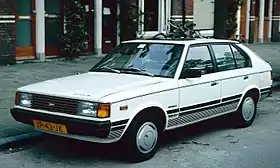 European specification of second generation Hyundai Pony hatchback in Utrecht, Netherlands | |
| Overview | |
| Manufacturer | Hyundai |
| Production | 1975-1990 |
| Assembly | Ulsan, South Korea |
| Body and chassis | |
| Class | Subcompact car (B) |
| Layout | FR layout |
| Chronology | |
| Successor | Hyundai Excel Hyundai Elantra |
Background
When Hyundai wanted to develop their own car, they hired George Turnbull, the former managing director of Austin Morris at British Leyland in 1974.[2] He in turn hired five other top British car engineers, Kenneth Barnett as body designer, engineers John Simpson and Edward Chapman, John Crosthwaite as chassis engineer and Peter Slater as chief development engineer.[3][4] With Turnbull's experience with the Morris Marina, [5] engines and transmissions from Mitsubishi, some parts from the Ford Cortina they were already producing, and a hatchback body styled by Italdesign Giugiaro, they developed the Hyundai Pony.
First generation (1975)
| First generation | |
|---|---|
.jpg.webp) Hyundai Pony sedan (New Zealand) | |
| Overview | |
| Production | 1975–1982 |
| Designer | Giorgetto Giugiaro at Italdesign |
| Body and chassis | |
| Body style | 2-door coupe utility 3-door hatchback 4-door sedan 5-door hatchback 5-door station wagon |
| Powertrain | |
| Engine |
|
| Transmission | 4-speed manual 3-speed automatic |
| Dimensions | |
| Wheelbase | 2,340 mm (92 in)[6] |
| Length | 3,970 mm (156 in)[6] 3,998 mm (157 in) (wagon)[6] |
| Width | 1,558 mm (61 in)[6] |
| Height | 1,360 mm (54 in)[6] |
| Curb weight | 870–935 kg (1,918–2,061 lb)[6] |
.jpg.webp)
.jpg.webp)
.jpg.webp)
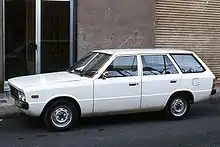
.jpg.webp)
The Pony was presented at the Turin Motor Show in October 1974, and the car was introduced in December 1975 as a four-door sedan to compete with the Saehan Gemini and Kia Brisa. A coupé utility version was added in May 1976, which was called Pick-up. Technically, a pickup has a separate cargo tray while the Pony had it integrated in the body. A station wagon arrived in April 1977. In 1981, the small bootlid from the sedan was replaced by a hatchback creating a new five-door model. This was accompanied with a new three-door hatchback. The Pony was loosely based on the Morris Marina, with former British Leyland engineers being hired by Hyundai to design the car.[7]
Hyundai began exporting the Pony to Chile, Argentina, Colombia, Ecuador and Egypt in 1976. European exports began in 1979 with Belgium and the Netherlands, with Greece added shortly thereafter. Export to the United Kingdom started in 1983 with the second generation Pony. The Pick-up version was added in October that year, only available with the smaller, 1.2 liter, engine and a 380 kg (838 lb) payload.[8]
The 1.2 L (1238 cc) four-cylinder engine claimed 55 PS (40 kW) and the 1.4 L (1439 cc) produced 68 PS (50 kW). The 1.4 GLS was tested by the British car magazine Motor and top speed was 92 mph with acceleration from 0–60 mph in 15.3 seconds.[9]
Lineup
- 1200:GLS/GL/Standard (UK: T, L, TL, GL)
- 1400:GLS/GL (UK: TL, GL, TLS, GLS)
- 1600:GLS/GL/Limited (not in all markets)
Second generation (1982)
| Second generation | |
|---|---|
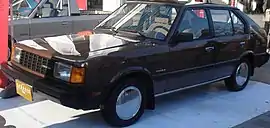  Second generation Hyundai Pony hatchback | |
| Overview | |
| Production | 1982–1990 |
| Body and chassis | |
| Body style |
|
| Powertrain | |
| Engine |
|
| Transmission | 4-speed manual 3-speed automatic |
| Dimensions | |
| Wheelbase | 2,340 mm (92 in)[10] |
| Length | 4,029 mm (159 in) (hatchback)[10] 4,184 mm (165 in) (Canada)[11] |
| Width | 1,566 mm (62 in)[10] |
| Height | 1,355 mm (53 in) (hatchback)[10] 1,367 mm (54 in) (Canada)[11] |
| Curb weight | 920–1,015 kg (2,028–2,238 lb)[10][11] |
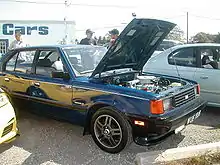
.jpg.webp)
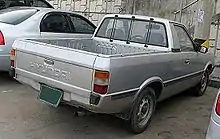
.jpg.webp)
In January 1982, the Pony II was presented. Although technically identical to the original Pony, due to the full restyling it's considered as the second generation Pony. Quoting a sales brochure: You'll see New Pony luxury in such things as rectangular halogen headlamps, fitted in a smart new radiator grille. You'll see it in the wrap-around indicators, completely re-styled rear lamp clusters and neatly designed instrument panel with easy-to-read gauges. These new refinements are just part of many distinctive features of the New Pony. The Pony II was only available as five-door hatchback and two-door Pick-up.
With the Pony II, export also began to the UK in the spring of 1982 – making it the first Korean car to be sold there. This marked the beginning of a very successful foray into the European market by Korean carmakers, with Kia arriving in 1991 and Daewoo in 1995. The Daewoo brand disappeared after a decade when General Motors decided to adopt the Chevrolet brand on its European market models, but Hyundai and Kia have both enjoyed increasing success on the UK market.
The Pony was also exported to Canada from 1983, but not to the United States because it did not pass federal emissions standards there (the Pony's successor model, the Excel, would be the first Hyundai car model to be sold in the United States). Canadian sales greatly exceeded expectations, and it was at one point the top-selling car in that market, as they were among the most inexpensive cars sold there. The Pony II was notorious for poor quality, although it afforded a much higher degree of quality and refinement in the lowest-price auto segment than the Eastern-bloc imports of the period then available, which helped Hyundai to get a foothold in that market.[12]
Engine types
For 1984, the Pony came only with a 1439 cc (88ci) 4G33 engine inline-four, rated at 70 hp (52 kW) and 82 lb·ft (111 N·m) of torque. This engine was available with either a four-speed or five-speed manual or a three-speed automatic transmission. The 1238 cc (74ci) 4G36 engine was not available in Canada. This engine was retained across the line until 1986, after which only the 1597 cc (97ci) 4G32 engine (74 hp (55 kW), 93 lb·ft (126 N·m) torque) was available. In mid-1985, the door handles were blacked out, chrome was removed from the windshield wipers, and the "HD" badge was removed from the center of the grille and replaced with the lettering "Hyundai" off to the left side. A 1.6-liter model 4G32 engine became available in 1985, with optional air conditioning. These powerplants had a hemispherical crossflow cylinder head, two valves per cylinder (chain-driven SOHC), a two-barrel downdraft carburetor (manual choke) and breaker point-type ignition.
Trim levels
Trim levels were L (standard), GL/CX, and GLS/CXL. The CX/CXL designations were for 1987 model years only. The L featured vinyl seats, a fold-down rear bench seat, and usually a four-speed manual transmission mated to a 1.4 L I4 engine. The GL/CX included vinyl-cloth seats, a standard clock (which was mounted in the instrument cluster for 1984-1986 models, and for 1987, a digital clock was added in the centre of the upper dash) rear wiper, passenger-side mirror, tinted glass, lockable fuel door, standard door guards, 50/50 fold-down seats, upgraded interior trim, and (from 1985) an available 1.6 L engine. The GLS/CXL included the above with the option of a tachometer, passenger-side vanity mirror, full cloth seats, and (from 1985) a standard 1.6 L engine.
Only the L and CX were trim levels for 1987. The L was the same as the previous L, however the clock was now digital and the CX had a standard tachometer. From 1986 to 1987, interior colors available were tan or blue. From 1984 to 1985, it was light gray on dark gray.
Options included rear window louvers, a front air dam, rear spoiler, GT package (which included a leather-wrapped Momo three-spoke steering wheel), tachometer, different trim and badging, fog lamps, and extra lights in the rear. All GTs came with the more powerful 1.6 L engine. The Pony pickup was sold in Europe (only) until the end of the 1980s.
The second generation Pony remained on sale until 1988 (until 1990 in South Korea). In some markets the Pony was replaced by a re-badged Hyundai Excel from 1985, particularly in Europe.
Lineup
- 1200 LE/L/GLX/GLS/GL/Standard
- 1400:GLS/GL/CX
- 1600:GLS/CX
Canadian-spec (Non-ECC LHD)
The Canadian version of the Pony had to be changed slightly to meet standards of that country. The Pony was released for sale in Canada for the 1984 model year and ended in 1987. Differences between the Canadian Pony versus its European counterparts were 8 km/h bumpers, sealed-beam headlights, side marker lamps instead of indicator repeaters (also in a lower position), and slight alterations in interior instrumentation and trim application. Initial projections for 1984 called for 5000 sales, but the final total was an astounding 25,123,[13] making the Pony one of Canada's best selling cars that year. The Pony was sold until 1987, even while Excels were for sale alongside.
Other models
In Europe, the front wheel drive Hyundai Excel was sold under the Pony name from 1985 as a replacement of the rear wheel drive version. In other markets, the second generation Pony continued on sale alongside the new Hyundai Excel. Until discontinuation, Excel carried the Pony name.
- The first generation Excel (X1) was called Pony in Europe from 1985 to 1987, and the face-lifted model from 1987-1989 was called the Pony XP.
- For the second generation Excel (X2), the hatchback versions were called Pony in Europe.
The final usage of the name was with the first generation Hyundai Accent, sold as the Pony in France. The Pony name was last used by Hyundai in 2000.
Super Pony
For the second and third generations, some taxi models of the Hyundai Accent were sold as "Hyundai Super Pony". The fourth generation used the name "Grand Pony" instead.
References
- "Hyundai Pony – Koreas First Mass-Produced Car in 1976". Koreatimes.co.kr. 2010-02-21. Archived from the original on 2013-12-26. Retrieved 2011-12-06.
- Wood, Jonathan (24 December 1992). "Obituary: Sir George Turnbull". The Independent. Retrieved 15 February 2012.
- The Times July 4th 1974
- The Engineer. Jan 30th 1975
- Korean connection
- "Dutch Hyundai Pony brochure". Flickr.
- James Taylor (26 March 2018). British Leyland: The Cars, 1968-1986. Crowood. p. 242. ISBN 978-1-78500-392-9.
- Kennett, Pat, ed. (September 1982). "What's New: Budget-price pick-up". TRUCK. London, UK: FF Publishing Ltd: 11.
- Motor March 1982
- "Dutch Hyundai Pony II brochure". Flickr.
- "Canadian Hyundai Pony II brochure". Flickr.
- Cheney, Peter. "10 worst cars chosen by our readers". The Globe and Mail. Retrieved 2011-12-06.
- "Import sales up on Pony express". Windsor Star. Windsor, Ontario. January 12, 1985. p. D12.
In 1984, Hyundai delivered 25,123 models